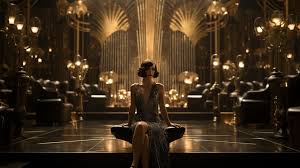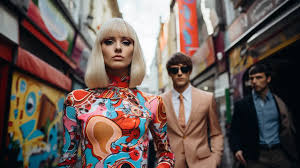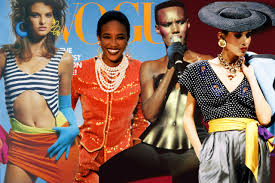Vintage fashion holds a timeless allure, inviting us to explore the elegance, creativity, and distinct styles that defined different eras. From the roaring 1920s to the eclectic 1990s, each decade brought its unique contributions to the fashion world. This comprehensive guide delves into the most influential vintage fashion trends from the 1920s through the 1990s, offering insights into how these styles have shaped contemporary fashion and remain relevant today.
1. The Roaring 1920s: Flapper Chic and Art Deco Elegance

The 1920s, known as the Roaring Twenties, was a period of significant social change and fashion innovation. The era is best remembered for its vibrant, liberated style that marked a departure from the more conservative fashion of the previous decades.
1.1. Flapper Dresses
Key Features:
- Drop Waist: Dresses with a loose, drop-waist silhouette that emphasized a more relaxed, boyish figure.
- Fringe and Beading: Elaborate embellishments such as fringe, sequins, and beads that added movement and sparkle to the dresses.
- Hem Length: Hemlines rose to knee-length, reflecting the era’s playful and carefree attitude.
Notable Designers:
- Coco Chanel: Known for her groundbreaking designs that popularized the simple, elegant look of the flapper dress.
- Jean Patou: Famous for his use of luxurious fabrics and innovative cuts.
1.2. Art Deco Influence
Key Features:
- Geometric Patterns: Sharp lines and geometric shapes that reflected the Art Deco movement’s emphasis on modernity and luxury.
- Bold Colors: Rich, vibrant colors and metallics that conveyed opulence and sophistication.
- Streamlined Silhouettes: Clothes with clean, straight lines and minimal embellishments.
Iconic Elements:
- Accessories: Art Deco jewelry, such as long, dangling earrings and geometric necklaces, became a popular addition to the flapper look.
- Evening Wear: Glamorous evening gowns with intricate beadwork and dramatic, flowing skirts.
2. The 1930s: Hollywood Glamour and Sophisticated Elegance
The 1930s was a decade marked by the Great Depression, yet fashion remained glamorous and refined, influenced heavily by Hollywood’s silver screen.
2.1. Hollywood Glamour
Key Features:
- Bias Cut: The bias cut technique created soft, draped silhouettes that enhanced the body’s natural curves.
- Longer Hemlines: Skirts and dresses fell to mid-calf or floor-length, reflecting a more conservative and elegant style.
- Luxurious Fabrics: Rich materials such as silk and satin became popular for evening wear.
Notable Figures:
- Marlene Dietrich: Known for her sophisticated and androgynous style, including tailored suits and glamorous gowns.
- Joan Crawford: Famous for her dramatic shoulder pads and glamorous, flowing gowns.
2.2. The Influence of the Golden Age of Hollywood
Key Features:
- Structured Dresses: Emphasis on strong shoulder pads and tailored waists to create an elegant, hourglass figure.
- Elegant Accessories: Feathered boas, long gloves, and sparkling jewelry complemented the high-fashion look.
Iconic Styles:
- Evening Gowns: Floor-length gowns with intricate detailing and glamorous draping.
- Day Wear: Tailored suits and modest dresses for daytime occasions.
3. The 1940s: Wartime Utility and Post-War Elegance
The 1940s were defined by World War II, which influenced fashion through utility and practicality, followed by a return to opulence as the war ended.
3.1. Wartime Utility
Key Features:
- Functional Clothing: Simple, practical designs that were easy to produce and maintain.
- Military Influence: Utility styles with practical elements such as epaulettes and pocket details.
- Fabric Restrictions: Use of synthetic fabrics and minimal adornments due to material shortages.
Notable Designers:
- Christian Dior: Revolutionized post-war fashion with the introduction of the New Look, emphasizing a return to femininity and luxury.
3.2. The New Look
Key Features:
- Full Skirts: Emphasis on voluminous skirts with full petticoats and cinched waists.
- Elegant Silhouettes: Focus on luxurious fabrics and intricate tailoring.
- Feminine Details: Incorporation of soft lines, delicate fabrics, and intricate embroidery.
Iconic Elements:
- Tea Length Dresses: Popular for both day and evening wear, often with full skirts and fitted bodices.
- Luxury Fabrics: Use of fine wools, silks, and taffetas.
4. The 1950s: Rock ‘n’ Roll and Retro Glamour
The 1950s were characterized by a vibrant post-war culture and a return to conservative, glamorous fashion, heavily influenced by the rise of rock ‘n’ roll and Hollywood icons.
4.1. Rock ‘n’ Roll Influence
Key Features:
- Casual Wear: Introduction of casual clothing such as denim jeans, leather jackets, and graphic tees.
- Youthful Styles: Bright colors, bold patterns, and a rebellious attitude defined the fashion of the younger generation.
Notable Figures:
- James Dean: Iconic for his rebellious style, including leather jackets and denim jeans.
- Elvis Presley: Influenced fashion with his distinctive rock ‘n’ roll style and stage outfits.
4.2. Retro Glamour
Key Features:
- Full Skirts: Emphasis on petticoats and A-line skirts that created a voluminous, feminine silhouette.
- Hourglass Figures: Tailored dresses that accentuated the waist and bust, reflecting the era’s glamorous style.
- Classic Accessories: Pearls, gloves, and elegant hats became staples of the fashion look.
Iconic Styles:
- Poodle Skirts: Popular among young women, often adorned with playful designs.
- Cocktail Dresses: Elegant dresses designed for evening events, often featuring fitted bodices and full skirts.
5. The 1960s: Mod Fashion and Cultural Revolution

The 1960s was a decade of cultural upheaval and experimentation, reflecting a dramatic shift in fashion towards youthful, avant-garde styles.
5.1. Mod Fashion
Key Features:
- Bold Patterns: Geometric shapes, bold stripes, and bright colors became prominent.
- Mini Skirts: The introduction of the mini skirt by designer Mary Quant marked a new era of youthful rebellion.
- Shift Dresses: Loose, straight-cut dresses that emphasized a minimalist look.
Notable Designers:
- Mary Quant: Known for her creation of the mini skirt and innovative designs.
- Pierre Cardin: Famous for his futuristic and geometric designs.
5.2. Hippie Influence
Key Features:
- Bohemian Styles: Flowing, relaxed garments, including maxi dresses, bell-bottom jeans, and fringe jackets.
- Ethnic Prints: Incorporation of global patterns and handcrafted elements.
Iconic Elements:
- Tie-Dye: Vibrant, multicolored patterns that became synonymous with the hippie movement.
- Vintage Denim: Emphasis on distressed, bell-bottom jeans and casual, comfortable wear.
6. The 1970s: Disco Fever and Eclectic Styles
The 1970s were characterized by a diverse range of styles, from the glamorous disco era to the laid-back bohemian look.
6.1. Disco Fashion
Key Features:
- Shiny Fabrics: Use of metallics, sequins, and other reflective materials for a high-glamour look.
- Flares and Jumpsuits: Flared pants and one-piece jumpsuits became popular, reflecting the disco culture’s flamboyance.
Notable Figures:
- Donna Summer: Iconic for her disco-inspired outfits and glamorous stage presence.
- Saturday Night Fever: The film’s fashion, including John Travolta’s iconic white suit, defined the era.
6.2. Boho Chic
Key Features:
- Ethnic and Vintage Influences: Incorporation of vintage finds, ethnic prints, and handcrafted details.
- Relaxed Fits: Comfortable, flowing garments that embraced a more laid-back aesthetic.
Iconic Styles:
- Maxi Dresses: Long, flowing dresses with bold prints and relaxed silhouettes.
- Fringe and Suede: Popular accessories and garments that added texture and bohemian flair.
7. The 1980s: Power Dressing and Bold Statements

The 1980s were marked by bold fashion choices, reflecting the era’s emphasis on power dressing and individualism.
7.1. Power Dressing
Key Features:
- Shoulder Pads: Dramatic shoulder pads that created a strong, authoritative silhouette.
- Tailored Suits: Sharp, tailored suits with bold colors and patterns for both men and women.
Notable Figures:
- Dynasty: The TV show’s glamorous costumes, including oversized shoulder pads and luxurious fabrics, influenced fashion trends.
- Madonna: Known for her bold, edgy fashion choices and influence on 80s style.
7.2. Casual Cool
Key Features:
- Athletic Wear: Incorporation of sportswear into everyday outfits, including tracksuits and sneakers.
- Graphic Tees: T-shirts with bold graphics and slogans that made a statement.
Iconic Styles:
- Acid Wash Jeans: Popular for their unique, distressed look.
- Sneaker Culture: The rise of branded sneakers as a fashion statement.
8. Conclusion
From the glamour of the 1920s to the bold statements of the 1980s and beyond, vintage fashion trends offer a rich tapestry of style and cultural significance. Each decade brought its unique contributions to the fashion landscape, reflecting societal changes, artistic movements, and evolving tastes. Understanding these vintage trends not only provides insight into the history of fashion but also offers inspiration for contemporary style. As we continue to draw on past influences, vintage fashion remains a testament to the enduring appeal of classic design and innovation.


